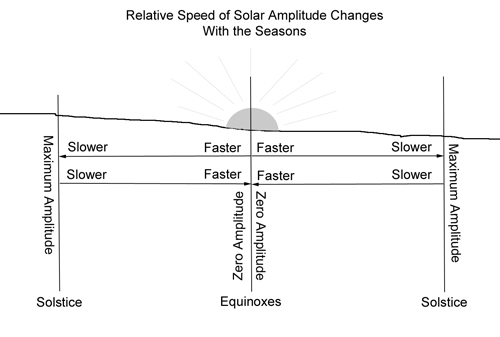Announcement: My online Land Navigation course includes four hours of video instruction, and two downloadable PDF books, all for about the same price as a typical paperback book. Get my Land Navigation course here.
How the Sun's
Amplitude Changes
The sun's amplitude changes do not occur evenly throughout the seasons.
Instead, the sun's amplitude remains near its maximum around the time of the solstices longer than it remains near zero around the time of the equinoxes.
This means that the direction of sunrise and sunset changes relatively slowly in the days just before or after either solstice, but changes relatively quickly in the days just before or after either equinox.

For example, here at latitude 30 N where I live, the sun's maximum amplitude is 27 degrees. Only 14 days after the September (autumnal) equinox, the sun's amplitude is already 007 degrees, meaning the sun rises that day in the direction of 097 degrees (007 degrees south of east) and sets in the direction of 263 degrees ( 007 degrees south of west). Fourteen days before the December (winter) solstice, however, the sun's amplitude is already near its maximum of 027 degrees, being somewhat greater than 026 degrees.
Understanding the uneven nature of the sun's amplitude changes will better equip you to find directions by the sun. You'll factor it into your calculations when you set out on any given day to estimate the direction of sunrise and sunset.
Return from Amplitude Changes to Celestial Navigation
Return from Amplitude Changes to Home

